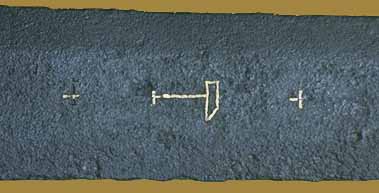

This close-up of this blade towards the hilt end (left) shows a flat central fullerless face which decreases in width proportionally with the width of the blade. The cross-section is that of a flattened hexagon with the somewhat narrower edge bevels appearing to be flat, that is, not hollow ground. On the better preserved side there is an inlay in yellow colored metal of what appears to be a hammer between two simple crosses; on the more corroded opposite side the inlay has fallen out, though an essentially identical series of marks remains discernible as grooves. In 1993, this mark was unique in Oakeshott's experience (see Oakeshott 1993, p. 11 & 14 where a brief description of this sword was first published).